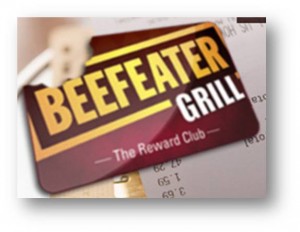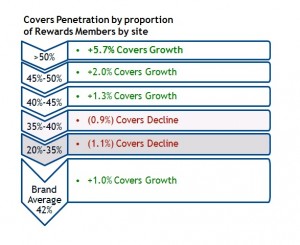Creating loyalty for restaurants
Winning commitment from casual diners at Whitbread’s restaurant brands
The brief
Whitbread is a large UK hospitality business with major lines of business in coffee shops with Costa Coffee, in hotels with Premier Inn and in restaurants with Beefeater, Table-Table & Brewers Fayre restaurant brands.
With competition hotting up for committed ‘casual diners’ Whitbread’s restaurant brands needed to be able to engage with loyal diners visiting each branch frequently. Without some sort of programme through which to connect directly with these customers, the value from such high spenders was at risk.
Strategy
So if loyalty was the purpose in mind, and regular diners were the targets, then the brief was for some sort of loyalty programme for diners to enrol in. Proposed as a pilot at first to deploy across just 30 Beefeater restaurants, Whitbread could test and establish whether a points based loyalty programme could work for Beefeater.
Actions
After a short tender process, we selected a partnering supplier to work with in scoping, specifying and building a pilot programme. The pilot would need to be able to be scaled up and rolled out if proven to be effective, or closed if not. If rolled out it should also be able to be applied across other Whitbread restaurant brands.
Restaurant till systems would register transaction data from all of our restaurants, feeding the data into Whitbread centrally for copying out to our partnering supplier. Through using low cost magstripe membership cards at the till, we could associate any transaction with a member collecting points from it.
Just five months later, the pilot programme launched with carefully planned briefings for staff at the 30 Beefeater pilot restaurant sites. With an initial focus on acquiring members at sites, the role of staff in pitching and promoting the programme would be crucial.
Our systems and data supporting the programme could count and measure every aspect of ‘Beefeater Reward Card’ customer spend in restaurants. So early reporting and analysis from sites, crunching the data, would be important.
The Big Difference
Early signs were good, with a high scale of sign-ups although some sites acquired more effectively than others. Within weeks it became clear that some sites were pushing the programme more than others.
After just three months, careful data analysis showed a clear correlation between the sites more active in enrolling their diners and growth in covers (the number of individual diners) year on year. This ‘killer slide’ convinced sites with lower scale of enrolment to get on board.
Sites with more than 50% of Reward Club members amongst their diners grew covers by close to +6% year on year; those with a below average proportion of Reward Club members saw a year on year decline.
This clear connection between the programme and commercial performance was enough to convince Whitbread to rollout the programme to all Beefeater restaurants; and subsequently to more of their restaurant brands throughout the UK.
After a full year of operation of the Beefeater programme with 750,000 cards issued, we could count over 330,000 as ‘active’ members. Members accounted for 30% of ‘checks’ (bills), 40% of revenues & close to 50% of all covers (diners). Further analysis proved that the programmes delivered +1.5% in growth year on year over and above growth from any other business activity. For Whitbread’s restaurant brands, this growth gave an ROI for the programme of over 8:1, whilst protecting and winning over high spending customers from competitors.
To read another of our case studies about Whitbread at Premier Inn Click here. Or to read another case study about marketing driving business growth Click here.
Or if you’re ready to get in contact click here.







